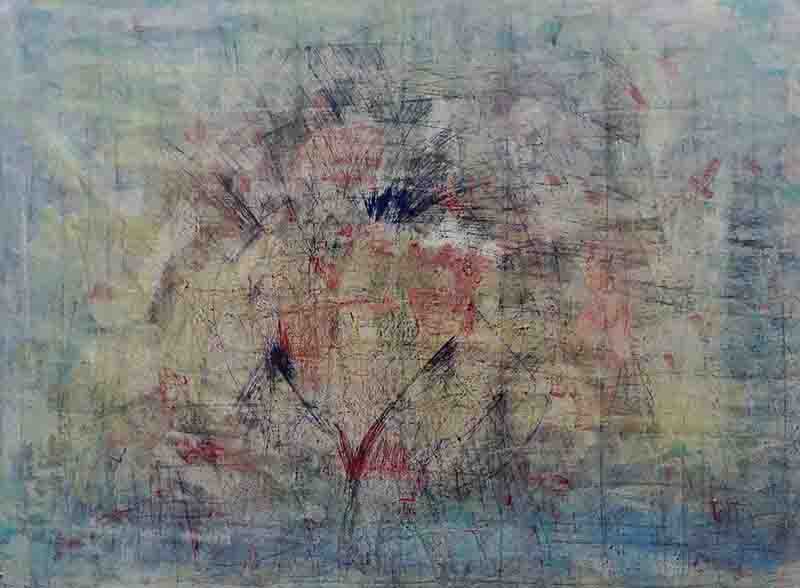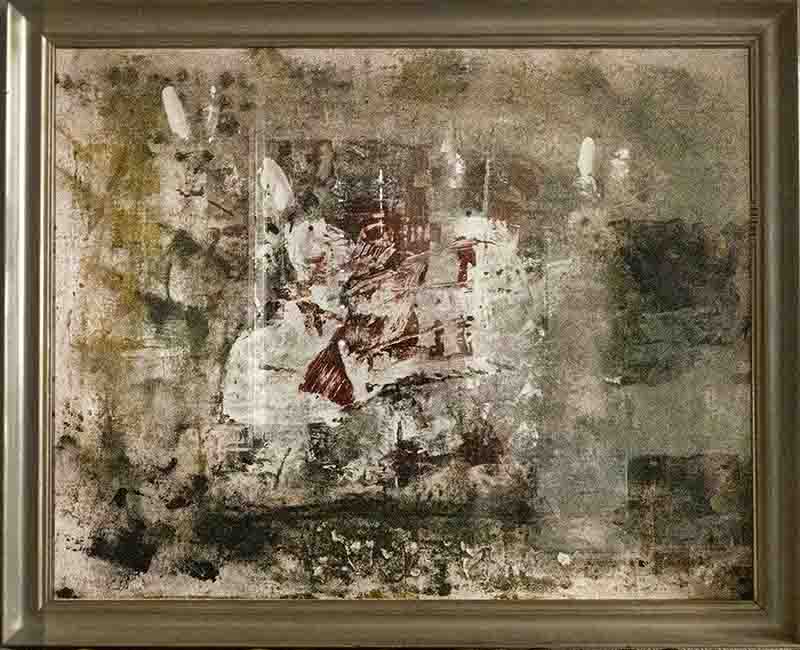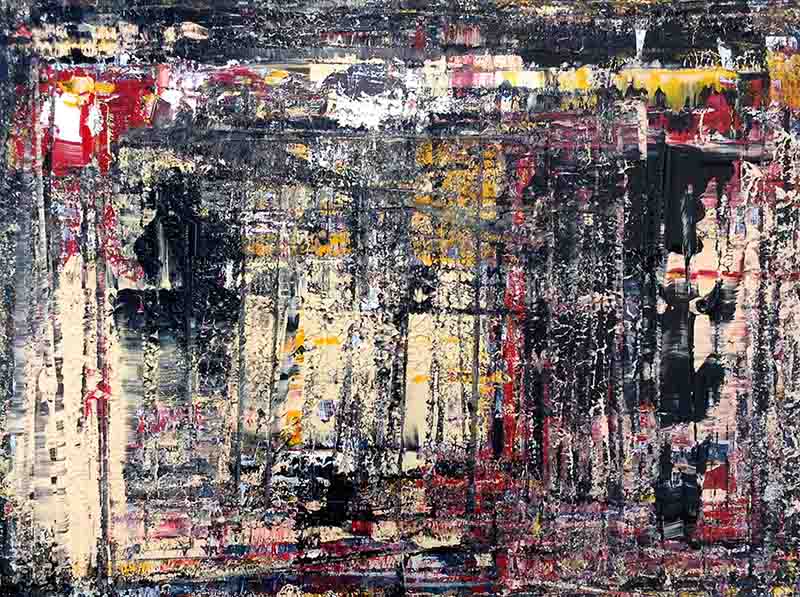Exploring the World of Acrylic Art
Acrylic art is a versatile technique known for its vibrant colours and quick-drying properties. Artists use acrylic paints to create wide range of artworks, spanning from daring abstract compositions to intricate sceneries.

Acrylic art has become a popular choice for artists due to its ease of use, affordability, and wide range of expressive possibilities.
Acrylic art involves the use acrylic colours made from pigment suspended in an acrylic polymer emulsion to create dynamic and vibrant works of fine art.
These paints, known for their vibrant colors and quick drying time, offer a wide range of creative possibilities and can be used on various surfaces, including canvas, paper, wood, and fabric.
Acrylic art has become a staple in contemporary art, attracting both new and established artists and art buyers.
The Pop Art movements enjoyed the ability of acrylic to create graphic, flat colours, while contemporary artists are constantly developing the enormous possibilities of the medium.
By understanding the characteristics, techniques, and market trends associated with acrylic art, both artists and art collectors can fully appreciate and leverage its potential.
Whether used by beginners or professional artists, acrylic paints offer endless possibilities for creativity and innovation.
The world of high-end acrylic art is a fascinating interplay of artistic expression, market trends, and savvy investment.
12 Facts to know about Acrylic Art
-
Growing Popularity: Acrylic art has seen a surge in popularity in the art market due to its vibrant colors, versatility, and durability.
-
Diverse Styles: Acrylic artworks encompass a wide range of styles, from traditional paintings to contemporary and abstract compositions, catering to diverse collector preferences.
-
Durability: Acrylic artworks are durable and less prone to cracking or yellowing over time, making them suitable for long-lasting creations.
-
Compatible with Mixed Media: Acrylic paints can be combined with other mediums such as pastels, ink, or collage materials, enabling artists to create mixed media artworks.
-
Multiple Techniques: Artists can employ various techniques with acrylics, including layering, blending, texturing, and pouring, to achieve different effects.
-
Vibrant Results: Acrylic paints produce vibrant and opaque colors, offering artists the ability to create bold and expressive artworks.
-
Collector Demand: Collectors are increasingly drawn to acrylic art for its aesthetic appeal, accessibility, and potential for investment.
-
Emerging Artists: The acrylic art market is fueled by emerging artists who bring fresh perspectives and innovative approaches to the medium, attracting attention from collectors and galleries.
-
Established Figures: Established artists who specialize in acrylics, such as Robert Motherwell, Andy Warhol, Timothy Mulligan, Roy Lichtenstein, and Helen Frankenthaler, command significant attention and demand in the art market.
-
Art Fair Presence: Acrylic art is prominently featured at art fairs around the world, providing artists and galleries with opportunities to showcase their works to a global audience of collectors and enthusiasts.
-
Online Platforms: The rise of online art platforms and galleries has expanded the reach of acrylic art, allowing artists to connect directly with collectors and bypass traditional gallery channels.
-
Investment Potential: Acrylic artworks have shown strong investment potential, with prices for notable pieces steadily appreciating over time as artists gain recognition and acclaim.
The Pop Art movements enjoyed the ability of acrylic to create graphic, flat colours, while contemporary artists are constantly developing the enormous possibilities of the medium.
Acrylic Art: Timeline
Acryl paint was introduced in Germany in the 1930s and initially used for commercial applications.
It quickly gained popularity among artists for their vibrant colors and ease of use.
| Year | Milestone |
|---|---|
| 1934 | German Chemist Otto Röhm invents acrylic resin, laying the foundation for acrylic paint development. |
| 1940s | Acrylic paints are introduced as commercial products, initially used for industrial purposes such as automotive coatings. |
| 1950s | Artists begin experimenting with acrylic paints for fine art applications due to their fast drying time and versatility. |
| 1960s | Acrylic paints gain popularity among artists, particularly in the United States, as they offer a more vibrant color range and easier cleanup compared to oil paints. |
| 1970s | Acrylic pouring techniques emerge as artists explore new ways to manipulate acrylic paints, leading to the development of abstract and fluid art styles. |
| 1980s | Advances in acrylic paint formulations result in the introduction of high-quality pigments, mediums, and additives, expanding the possibilities for artists. |
| 1990s | Acrylic art becomes increasingly recognized in the contemporary art world, with prominent artists incorporating acrylics into their works and exhibitions. |
| 2000s | Online communities and social media platforms provide a platform for acrylic artists to connect, share techniques, and showcase their work globally. |
| 2010s | Acrylic pouring gains widespread popularity as a trending art form, fueled by viral videos and tutorials on social media platforms like YouTube and Instagram. |
| Present | Acrylic art continues to evolve, with artists pushing the boundaries of traditional techniques and experimenting with new materials and technologies. |
This timeline gives a brief overview of acrylic painting and its triumphant success on the international art market.
In Living Color: Vibrant Perspectives in Acrylic Artistry

With its accessibility and affordability, acrylic art has become popular among artists of all skill levels, contributing to its widespread appeal in the art world.
Characteristics of Acrylic Paints
One of the most appealing aspects of acrylic art is its versatility.
Acrylic paints can be used to mimic the appearance of oil paints, watercolors, or even gouache, depending on how they are applied and diluted.
This adaptability allows artists to experiment with a wide range of styles and techniques.
Acrylics can be applied to various surfaces, including canvas, paper, wood, metal, and fabric.
This flexibility makes them suitable for different types of artistic projects, from traditional paintings to modern mixed media pieces.
Once dry, they become water-resistant and are less prone to yellowing or cracking compared to other paints.
The durability of acrylic paints ensures that artworks retain their original vibrancy and quality over time.
Unlike oil paints, which can take days or even weeks to dry, acrylics dry quickly, allowing for faster project completion.
Techniques in Acrylic Art

With their bold colours and expressive brushstrokes, acrylic paintings invite the viewer to descend into the universe of the artist.
Layering is a common technique in acrylic art that involves building up multiple layers of paint to create depth and texture.
This technique is particularly effective in creating realistic depictions of light and shadow, as well as adding complexity to abstract compositions.
Blending is another essential technique in acrylic art, involving the smooth merging of colors to achieve soft transitions and gradients.
It is particularly effective in creating realistic skin tones, atmospheric backgrounds, and dynamic color transitions in abstract works.
Artists use palette knives, sponges, brushes, and other implements to add texture and dimension to their paintings.
This technique is often used to add visual interest and complexity to abstract and mixed media pieces.
Popular methods of texturing include impasto, sgraffito, and collage, each offering unique possibilities for creative expression.
Acrylic pouring is a technique that involves mixing acrylic paint with a pouring medium to create fluid, marbled effects.
This technique has gained popularity for its ability to produce unique, unpredictable patterns and vibrant color combinations.
Market Trends in Acrylic Art
The demand for acrylic art is driven by various factors, including the popularity of contemporary styles and the versatility of the medium.
Collectors and investors are increasingly drawn to acrylic artworks for their vibrant colors and durability.
Popular styles in the acrylic art market include abstract expressionism, realism, and mixed media.
The demand for acrylic art is also influenced by trends in the broader art market, with collectors seeking unique and innovative pieces.
Pricing Acrylic Art

Whether displayed in galleries or as wall decoration in the lounge, acrylic art adds a certain touch of independence and inspiration to interior design.
Pricing for acrylic artworks can vary widely based on factors such as the artist's reputation, the size and complexity of the piece, and current market trends.
Established artists can command high prices for their acrylic works, while emerging artists may offer more affordable options.
The value of acrylic art is often determined by its originality, quality, and provenance.
Buyers should consider these factors when assessing the price of an original artwork and making purchasing decisions.
Tips for Collectors
When purchasing acrylic art, buyers should consider several key factors to ensure they are making informed decisions.
Assessing the quality and authenticity of the artwork is crucial.
Buyers should also research the artist's background and reputation, as well as the provenance of the piece.
Consulting with art dealers, art curators, and experts can provide valuable insights and help buyers navigate the acrylic art market.
Collectors should adopt strategies for building a valuable collection, including staying informed about market trends and emerging artists.
By making strategic investments and maintaining a keen eye for quality, collectors can build a portfolio of acrylic art that holds lasting value.
Applications of Acrylic Art
Acrylic paints are widely used in fine art, with artists creating both traditional and contemporary works.
Acrylics are favored for their ability to maintain color vibrancy and integrity over time.
The versatility of acrylics allows fine artists to experiment with different styles and techniques, making them a popular choice in the contemporary art scene.
-
Acrylic Paints: Water-based paints made of pigment suspended in acrylic polymer emulsion. They dry quickly, are water-resistant when dry, and can be thinned with water or mixed with acrylic mediums for various effects.
-
Acrylic Brushes: Brushes designed specifically for use with acrylic paints, typically made with synthetic bristles that are more durable and less prone to damage from acrylic paints than natural hair brushes.
-
Canvas Boards: Stiff boards covered with canvas fabric, providing a sturdy surface for acrylic painting. They come in various sizes and are convenient for framing or displaying without additional support.
-
Acrylic Mediums: Additives used to alter the consistency, texture, drying time, and finish of acrylic paints. Examples include gloss medium, matte medium, gel medium, and molding paste.
-
Palette Knives: Versatile tools with flat, flexible blades used for mixing paints on a palette, applying paint to canvas with textured effects, and scraping paint for artistic effects.
-
Acrylic Paper: Heavyweight paper specially formulated to withstand acrylic paints without warping or buckling. It provides a convenient alternative to canvas for practice or small-scale paintings.
-
Easels: Supportive structures used to hold canvases or painting surfaces upright while working. Easels come in various designs, including tabletop, tripod, and studio easels, offering stability and adjustability for artists.
-
Paint Palettes: Surfaces used for mixing and holding paints during the painting process. They come in different materials such as plastic, ceramic, and wood, offering options for easy cleanup and paint conservation.
-
Gesso: Primer applied to painting surfaces to create a smooth, uniform surface and improve paint adhesion. It seals and protects the surface while providing a suitable ground for acrylic painting.
-
Acrylic Varnish: Protective coating applied to finished acrylic paintings to enhance color saturation, protect against UV damage, and provide a glossy, satin, or matte finish. It can be brushed or sprayed onto the surface.
-
Paint Thinner: Solvent used to dilute acrylic paints, clean brushes, and remove paint from surfaces. It evaporates quickly and is less toxic than traditional oil-based paint thinners.
-
Acrylic Resin: Synthetic polymer material used as a binder in acrylic paints and mediums. It provides adhesion, flexibility, and durability to acrylic formulations, allowing for a wide range of applications and techniques.
Acrylic art is a popular and versatile form of painting that uses acrylic paints as the primary medium.
High-End Acrylics: Where Art and Investment Collide
Acrylic art, with its bold colors and versatile techniques, has captivated artists and art enthusiasts alike for decades.
Acrylic art has become a popular choice for artists due to its ease of use, affordability, and wide range of expressive possibilities.
Acrylic paint, once viewed as a student's medium, has soared to new heights in the contemporary art market.
While its affordability remains a draw for many artists, the unique properties of acrylics have also propelled them into the realm of high-end art.
Large-scale acrylic paintings, particularly those by established or rising stars, become significant investments due to their rarity and the sheer amount of artistic effort poured into them
As the market for contemporary art continues to flourish, so does the value of high-end acrylic pieces.
Acrylic Art: FAQ
Are you curious about music, art, technology, fashion, lifestyle, and beer?
If so, then you need to subscribe to the free Likewolf newsletter.
100% privacy. When you sign up, we'll keep you posted.
Artistic Prestige
Artist With Rising Reputation
